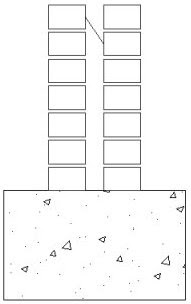Autocad Concrete Hatch


When using concrete hatch in Model space (Autocad 2002) in some drawings the small triangles formed as part of the concrete hatch don't join up correctly. So you end up with what looks like dashed lines going in every direction. I was talking to a workmate & he also mentioned he has this problem as well, his solutiuon is to take the object to be hatched into a seperate drawing that dosen't have this problem, hatch it & reinsert to his working drawing, which works quite well but I would like to clarify this problem as a opposed to avoiding it. Any help or ideas would be great. Hi, The problem is a result of inadequate numerical precision in the pattern specification showing up at locations remote from the hatching origin. The pattern works fine up close to the hatching origin, which is why moving SNAPBASE or the UCS closer to the hatched area helps - fewer repetitions of the hatch pattern occur between the origin and the viewed pattern portion.
Most hatch patterns lose registration on very extended repetition, some faster than others. You can also fix the problem with a more precisely specified hatch pattern as an alternative to adjusting drawing limits or moving SNAPBASE to and fro. Further information on this subject can be found here - Advertisement material *removed*, for further information please refer to the following - Do not post advertising or self promotional material or links to them to the Forum. We realize that there is a gray area where it may be necessary to do so to provide technical solutions. We also recognize blatant self promotion. To advertise on AUGI, please contact the Augiworld Magazine staff.
Thanks, Mike (Forum Moderator) regards, Hugh Adamson. Hi Hugh I hope you can understand why I *removed* the part I did, in it's original form I felt the post definitely crossed into that grey area.
I also honestly hope you realise this is nothing personal, it is just me (with Moderator hat on) trying to do the best I can. My intention was not to mislead, I thought hard and long if I should have removed all references to 'cadro.com' but decided that would be unfair and slightly unjust. Therefore how would you like me to correct the 'misleading' part or would you care to correct it yourself (I honestly don't mind)? Please bear in mind I won't restore the original content nor do I expect you to do so.
CAD Forum - CAD/BIM Library of free blocks - concrete hatch p - free CAD blocks and symbols (DWG+RFA+IPT, 3D/2D) by CAD Studio. When using concrete hatch in Model space (Autocad 2002) in some drawings the small triangles formed as part of the concrete hatch don't join up correctly.
I've now slightly amended my edit, hopefully it's no longer 'misleading'. Thanks for your understanding and support on this matter, Mike Forum Moderator. The original AR-CONC hatch pattern in AutoCAD was created back in 1988, I believe, in connection with Autodesk's then AEC product. Machines were slow (think 286 & 386), long hatch pattern definitions definitely slowed down drawing speed, so compressing the 30 odd line concrete hatch pattern definition down to its present 13 line size, and greatly increasing the randomization (certainly not perfect) was a big improvement. At the time, no one thought about hatching out to the boundaries of precision, sorry. Now with the ability in 2006 to respecify the origin for an existing hatch, this should be less of a problem.
Choose from: • Predefined hatch patterns. Choose from over 70 ANSI, ISO, and other industry-standard hatch patterns, or add hatch pattern libraries supplied by other companies. • User-defined hatch patterns.
Define your own hatch patterns based on the current linetype, with spacing, angle, color, and other properties you specify. Design Bulletin 32 Manual For Streets Department here. • Custom hatch patterns.
Hatch patterns are defined in the acad.pat and acadiso.pat ( acadlt.pat and acadltiso.pat for AutoCAD LT) files. You can add custom hatch pattern definitions to these files. • Solid fill. Fill an area with a solid color. • Gradient fill. Fill an enclosed area with a color gradient.
A gradient fill can be displayed as a tint (a color mixed with white), a shade (a color mixed with black), or a smooth transition between two colors.